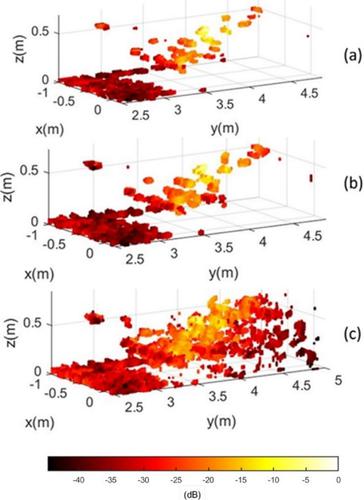当前位置:
X-MOL 学术
›
IET Radar Sonar Navig.
›
论文详情
Our official English website, www.x-mol.net, welcomes your feedback! (Note: you will need to create a separate account there.)
Laboratory multistatic 3D SAR with polarimetry and sparse aperture sampling
IET Radar Sonar and Navigation ( IF 1.7 ) Pub Date : 2024-01-01 , DOI: 10.1049/rsn2.12528 Richard Welsh 1 , Daniel Andre 1 , Mark Finnis 2
IET Radar Sonar and Navigation ( IF 1.7 ) Pub Date : 2024-01-01 , DOI: 10.1049/rsn2.12528 Richard Welsh 1 , Daniel Andre 1 , Mark Finnis 2
Affiliation

|
With the advent of constellations of SAR satellites, and the possibility of swarms of SAR UAV's, there is increased interest in multistatic SAR image formation. This may provide advantages including allowing three-dimensional image formation free of clutter overlay; the coherent combination of bistatic SAR geometries for improved image resolution; and the collection of additional scattering information, including polarimetric. The polarimetric collection may provide useful target information, such as its orientation, polarisability, or number of interactions with the radar signal; distributed receivers would be more likely to capture any bright specular responses from targets in the scene, making target outlines distinct. Highlight results from multistatic polarimetric SAR experiments at the Cranfield University GBSAR laboratory are presented, illustrating the utility of the approach for fully sampled 3D SAR image formation, and for sparse aperture SAR 3D point-cloud generation with a newly developed volumetric multistatic interferometry algorithm.
中文翻译:

采用偏振测量和稀疏孔径采样的实验室多基地 3D SAR
随着 SAR 卫星星座的出现以及成群的 SAR 无人机的出现,人们对多基地 SAR 图像形成的兴趣日益浓厚。这可以提供的优点包括允许无杂乱覆盖的三维图像形成;双基地 SAR 几何结构的相干组合可提高图像分辨率;以及收集额外的散射信息,包括偏振信息。极化收集可以提供有用的目标信息,例如其方向、极化率或与雷达信号的交互次数;分布式接收器更有可能捕获场景中目标的任何明亮镜面反射响应,使目标轮廓清晰。介绍了克兰菲尔德大学 GBSAR 实验室多基地偏振 SAR 实验的重要结果,说明了该方法在完全采样 3D SAR 图像形成以及使用新开发的体积多基地干涉测量算法生成稀疏孔径 SAR 3D 点云方面的实用性。
更新日期:2024-01-01
中文翻译:

采用偏振测量和稀疏孔径采样的实验室多基地 3D SAR
随着 SAR 卫星星座的出现以及成群的 SAR 无人机的出现,人们对多基地 SAR 图像形成的兴趣日益浓厚。这可以提供的优点包括允许无杂乱覆盖的三维图像形成;双基地 SAR 几何结构的相干组合可提高图像分辨率;以及收集额外的散射信息,包括偏振信息。极化收集可以提供有用的目标信息,例如其方向、极化率或与雷达信号的交互次数;分布式接收器更有可能捕获场景中目标的任何明亮镜面反射响应,使目标轮廓清晰。介绍了克兰菲尔德大学 GBSAR 实验室多基地偏振 SAR 实验的重要结果,说明了该方法在完全采样 3D SAR 图像形成以及使用新开发的体积多基地干涉测量算法生成稀疏孔径 SAR 3D 点云方面的实用性。



























 京公网安备 11010802027423号
京公网安备 11010802027423号